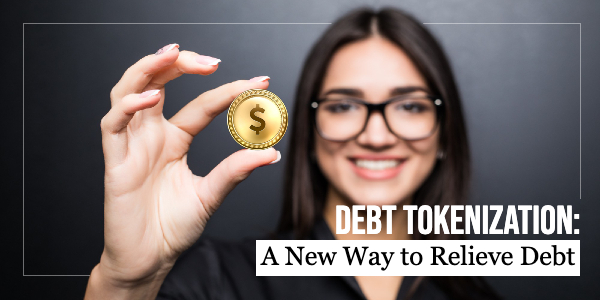Developments in blockchain technology have shown signs of influence in various industries as of late. Among them, the financial sector has seen the most impact. Currently, security tokens are growing popular in the financial market. This is because companies prefer the decentralized finance-related benefits of blockchain usage.
So, what exactly are debt tokens?
What should you expect to see with tokenization for debt relief in the future?
Read ahead to understand debt tokenization as a concept and how it relates to debt relief.
Concept of Debt Tokenization
The tokenization process involves developing a digital form of real-world assets, i.e., tokens. These can include different types of illiquid assets. “Initially, tokens mainly represented crypto assets like Bitcoin or Ethereum, but now, tokenization encompasses traditional assets like debt, equity, and real estate,” said John Kyprianou, a Crypto Researcher at Crypto Academy.
People can now provide the details of their dues and the payment due date in a digital receipt format. These receipts or tokens are simpler for tracking transactions/debt payments.
Companies and individuals can sell their tokens to other lenders on their own. They can do so without involving centralized financial institutions like banks or brokers. Also, they can manage a smooth transfer of assets, among other benefits.
What are Debt Security Tokens?
Many real-world assets can become digitized and put onto the blockchain. Among them, a debt security token mainly applies to debt instrument types.
There are two key factors:
- Dividend: This is the income/interest amount the debtor will pay their investors at maturity or monthly.
- Risk: If the borrowers cannot pay off the debt balance or interest on time due to drastic changes in the capital markets or other reasons, they are at “risk.”
The value of the tokenized debt is inversely proportional to the risk level. But, higher dividends assure a better valuation of these digitized bonds. Know this first when understanding the debt tokenization- debt relief connection.
Benefits to Expect from Debt Tokenization
People can get many advantages from using tokenized assets for debt relief services. They include:
- Transactions of debt tokens occur via blockchain. It is easier for both parties in the deal to customize the terms as they want. These include the repayment deadline, interest rates, etc.
- Tokenized bonds are more flexible compared to non-fungible tokens like NFTs or other financial assets. It is easier for both parties in the deal to customize the terms like repayment deadline and interest rates as per their situation.
- There is no need to depend on brokers and banks for deals. Professional investors can directly issue and manage their transactions via smart contracts.
- Borderless transactions are possible via blockchain, improving the traceability of different digital assets. Thus, investors can trade their tokens with global clients.
Common Problems Associated with Debt Tokenization
Indeed, debt tokenization has many uses for debtors and lenders, e.g., blockchain’s transparency. Yet, depending on debt tokenization can become challenging in some aspects, like:
- Blockchain technology is not safe from cybercrime or technical issues.
- There is a legal risk of using tokenized debt instruments and commodities for lenders and debtors. For example, it is hard to get valid legal support from courts in case of defaults or disputes since blockchain is decentralized in nature.
- The issuance of any debt security token depends heavily on the collateral on the line and the borrowers’ creditworthiness. So, the lenders may face the issue of delays or total loss if the borrower turns insolvent.
- The token value can fluctuate if the capital market is volatile or has low liquidity.
Noteworthy Trends Related to Debt Tokenization
Without a doubt, the impact of digitizing corporate bonds is huge for both lenders and borrowers. Its two key factors include:
- Accessibility to multiple capital markets.
- The efficiency of transactions, with the smoother trading process, payments, etc.
In this context, some trends are worth noting about debt management in the tokenization era:
Democratizes more investment options
Investors can transfer illiquid assets since fractional ownership is acceptable under the blockchain. So, people can buy parts of new collectibles or sell what they own instead of getting the whole asset. Examples include art pieces, private equity, etc. So, professional investors get more profit from each asset.
Standardization of smart contracts
It automates most processes while running on the blockchain via codes. Indeed, tokens directly perform the tasks on command.
To elaborate, these protocols help in three manners:
- Completing the pending debt payments at maturity/timely intervals to lenders (settlement)
- Distributing the new debt tokens to investors after creating them. Smart contracts follow the set criteria like maturity date, interest rate, etc. (issuance)
- Handling peer-to-peer trading between investors and borrowers without any middle connector (trading)
Improved market liquidity
Any illiquid asset class considered non-tradable is open for trading with debt tokenization. So, that increases the fluidity of assets like equity shares inside the market. Then, it improves trading efficiency.
Motivating regulatory upgrades
There is a high demand for debt tokenization across markets. Naturally, there is an increase in new players as well. Thus, the already-present frameworks cannot apply to all financial asset types or practices.
For example, stock market exchange and trading rules will not work for other asset classes in the secondary market. So, shifting to tokenization also motivates regulators to update their laws.
Regulation of Debt Security Tokens- What to Keep in Mind
Companies get more data when dealing with digitized corporate bonds, equity shares, and asset classes. Then it becomes vital to manage the tokenized equity. These tokens come within the competence of the state legal jurisdictions where the transaction began. So, keep that in mind while researching what rules apply.
“There are potential risks associated with debt tokenization,” said Luciano Colos, Founder and CEO of PitchGrade. “One key challenge is the need for proper regulatory frameworks to ensure compliance, investor protection, and risk mitigation. Transparency and disclosure standards are crucial to maintaining investor trust and preventing fraudulent activities in the tokenized debt market.”
It is important to note that all countries have different security laws in place for security token offerings or STOs. They apply to selling and distributing corporate bonds, equity, and other financial commodities.
But, given the decentralized nature of blockchain, not all rules apply to these digital assets. So, you should stay more alert about meeting compliance rules while working with tokenized debts.
Potential risks associated with debt tokenization
There are a number of potential risks associated with debt tokenization, including:
- Regulatory risks: The regulatory landscape for debt tokenization is still evolving, and it is not yet clear how all countries will regulate this new technology. This could pose a risk to businesses and investors who are not familiar with the applicable regulations.
- Cybersecurity risks: Debt tokens are digital assets, and as such, they are vulnerable to cyberattacks. This could lead to the theft of funds or the loss of data.
- Liquidity risks: Debt tokens are a relatively new asset class, and there is not yet a large and liquid market for them. This could make it difficult for investors to buy and sell debt tokens quickly and easily.
Questions and answers about the regulatory landscape for debt tokenization:
-
What are the specific regulatory requirements for issuing and trading debt tokens in different countries?
The regulatory requirements for issuing and trading debt tokens vary from country to country. In some countries, debt tokenization may be subject to the same regulations as traditional debt securities, while in other countries, it may be subject to new or emerging rules. It is important for businesses and investors to carefully research the regulatory requirements in the countries where they plan to issue or trade debt tokens.
-
What are the risks of non-compliance with these regulations?
The risks of non-compliance with debt tokenization regulations can be significant. Businesses and investors that fail to comply with the law may be subject to fines, penalties, or even imprisonment. In addition, non-compliance can damage a business's prestige. This can affect their ability to raise more capital later due to loss of credibility.
-
How can businesses and investors mitigate these risks?
Businesses and investors can mitigate non-compliance risks with debt tokenization regulations by carefully researching the law and seeking expert legal advice. In addition, companies and investors should develop and implement appropriate compliance procedures to ensure that they are in compliance with the law. Researching all aspects of money management and decentralized finance will help prepare companies, investors, and even freelancers to mitigate such risks better.
What Lies in the Future for Managing Debts with the Tokenization Approach?
With so many potential benefits, more businesses start jumping into the market. Thus, new approaches in debt management, like tokenization, will continue to expand in the future. Companies can use long-term debt financing solutions to increase their acquisitions, staff, etc.
On a global scale, these measures will open up the job market and assure better economic efficiency. Thus, you can expect a bright future in debt relief practices in the tokenization era.









